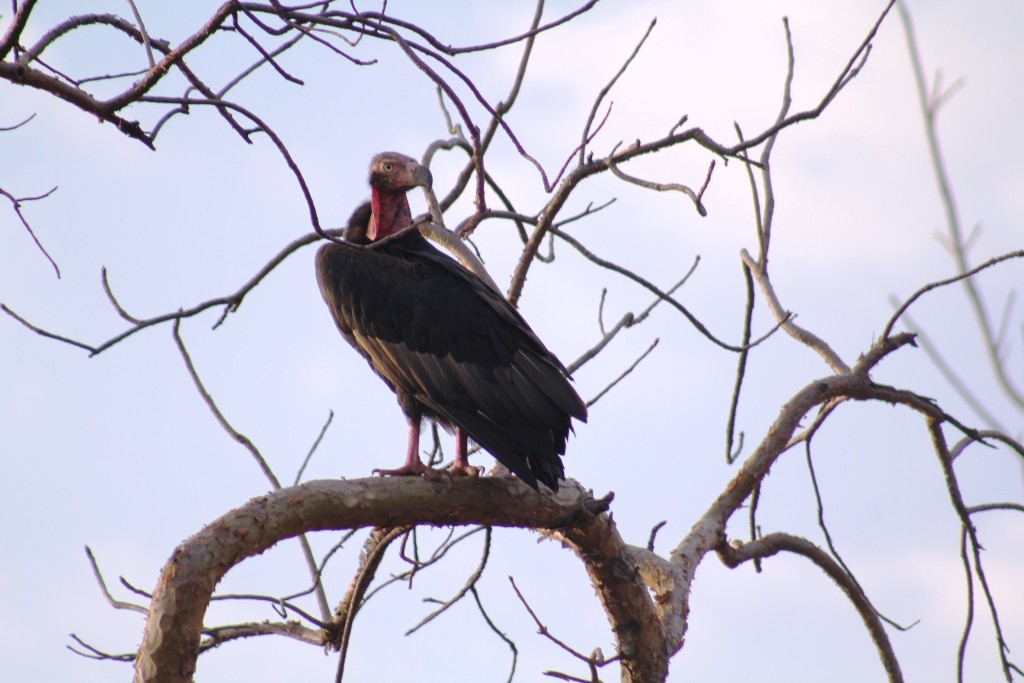Red-headed Vulture
A species of Red-headed Vulture Scientific name : Sarcogyps calvus Genus : Red-headed Vulture
Red-headed Vulture, A species of Red-headed Vulture
Botanical name: Sarcogyps calvus
Genus: Red-headed Vulture
Content
Description General Info
 Photo By Dhana1311 , used under CC-BY-SA-4.0 /Cropped and compressed from original
Photo By Dhana1311 , used under CC-BY-SA-4.0 /Cropped and compressed from original Description
It is a medium-sized vulture of 76 to 86 cm (30 to 34 in) in length, weighing 3.5–6.3 kg (7.7–13.9 lb) and having a wingspan of about 1.99–2.6 m (6.5–8.5 ft). It has a prominent naked head: deep-red to orange in the adult, paler red in the juvenile. It has a black body with pale grey band at the base of the flight feathers. The sexes differ in colour of the iris: males have a paler, whitish iris, whilst in females it is dark brown. 
Size
86 cm
Nest Placement
Tree
Feeding Habits
Red-headed Vulture predominantly scavenges carrion, particularly large mammalian remains, seldom domestics. It kleptoparasitizes from fellow vultures and raptors. Albeit timid and often subordinate at carcasses, red-headed Vulture may opportunistically consume animals affected by grass fires.
Habitat
Red-headed Vulture thrives in a range of habitats, including open landscapes, semi-deserts, cultivated lands, savannas, and deciduous woodlands. This species is also familiar with coastal regions and the lower mountain foothills, ascending to elevations as high as 3000 meters. Historically widespread, red-headed Vulture's distribution now centers around the South-Central and Southeast Asian territories, with strongholds in the Indian subcontinent. These vultures frequently inhabit regions near human settlements, reflecting their adaptability to diverse environmental conditions.
Dite type
Scavenger
General Info
Feeding Habits
Bird food type
Distribution Area
This gaudy-faced vulture was historically abundant, range widely across the Indian subcontinent, and also eastwards to south-central and south-eastern Asia, extending from India to Singapore. Today the range of the red-headed vulture is localized primarily to northern India. It is usually in open country and in cultivated and semi-desert areas. It is also found in deciduous forests and foothills and river valleys. It is usually found up to an altitude of 3000m from sea level. 
Species Status
The red-headed vulture used to be declining, but only slowly; in 2004 the species was uplisted to near threatened from least concern by the IUCN. The widespread use of the NSAID diclofenac in veterinary medicine in India has caused its population to collapse in recent years, however. Diclofenac is a compound now known to be extremely poisonous to vultures. The red-headed vulture population has essentially halved every other year since the late 1990s, and what once was a plentiful species numbering in the hundreds of thousands has come dangerously close to extinction in less than two decades. Consequently, it was uplisted to critically endangered in the 2007 IUCN Red List. Several NSAIDs have been found to be harmful to scavenging birds. Diclofenac, carprofen, flunixin, ibuprofen and phenylbutazone were associated with mortality. Meloxicam has thus far been found to be "Vulture-Safe" and its use in veterinary treatment of livestock is being encouraged. The red-headed vulture has started becoming more harder to come by as it is being hunted down. Places like Cambodia have put together special programs to help critically endangered vulture species. There has been evidenced compiled that showed hunters have started “ the use of poisons in hunting practices”, which has led to the population analysis showing “that since 2010 populations of the White-rumped Vulture Gyps bengalensis and Red-headed Vulture Sarcogyps calvus have declined, while the Slender-billed Vulture Gyps tenuirostris may also have started to decline since 2013”. 